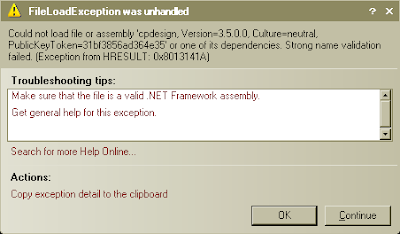(Interesting aside: In the above thread, Heath says he's had "Great Success" with InstallShield. Later in September 2000 you'll find threads where's promoting Wise and bashing InstallShield saying that it "sucks". Hmmm... anyways, I remember trying the InstallShield for Windows Installer back in the summer of 1999 and thinking both ISWI and MSI in general sucked. I would continue to use InstallShield 5 for the next 4 years! )
Back to my original thought: Some day soon will mark the official 10 year anniversary of Windows Installer. The problem is, I'm not sure what date exactly. I suppose it'll be Jan 27, 2009 since Wikipedia says this is the ship date of Office 2000. I was searching the usenet archives and I came across the very first thread to ever refer to windows installer on this date 10 years ago. I think you'll find it a fitting:
From: "Tom Savage"
Subject: Office 2000 install error 1601!
Date: 1998/12/30
Message-ID:
X-Deja-AN: 427080025
X-MimeOLE: Produced By Microsoft MimeOLE V4.72.3110.3
Newsgroups: microsoft.public.msdn.general
Can't install the msdn version of Office 2000 on two test machines. Install
updated the Windows installer and asked me to reboot. Now it stops almost
immediately with an "install error 1601".
Could it be related to my previous installation of Frontpage 2000 B1
(removed it before the current install, but uninstall mentioned a registry
write error)? I removed all Frontpage references I could find from the
registry, and it didn't help.
Would really appreciate any help you could give me on this one. I had grown
very comfortable with Frontpage2000 despite its quirks.
thanks,
ts
From: "Steven Toney"
Subject: Re: Office 2000 install error 1601!
Date: 1998/12/30
Message-ID: <#soTrZEN#GA.255@uppssnewspub04.moswest.msn.net>#1/1
X-Deja-AN: 427260501
References:
X-Priority: 3
X-MimeOLE: Produced By Microsoft MimeOLE V5.00.0810.800
X-MSMail-Priority: Normal
Newsgroups: microsoft.public.msdn.general
I think the new windows installer sucks!!
much to busy ,, difficult to tell plainly what is being installed and what
is not
install programs should be simple with clear choices and feedback on what
will be installed or removed.
this new program is none of these
steve
From: "Tom Savage"
Subject: Re: Office 2000 install error 1601!
Date: 1998/12/31
Message-ID:
X-Deja-AN: 427449318
References:
X-Priority: 3
X-MimeOLE: Produced By Microsoft MimeOLE V5.00.0810.800
X-MSMail-Priority: Normal
Reply-To: "Tom Savage"
Newsgroups: microsoft.public.msdn.general
_Lucky for me_ I found that c:\winnt\system32\msi.dll had not
self-registered during my repeated installations and uninstallations. I
registered it and the installation worked fine.
Well... almost fine. Now I have to get the Office2000 server extensions SQL
Server database to work right. "Version incompatibilities prevent
communication with the database". I'm using a hopelessly out-of-date and
incompatible SQL Server (v6.5 SP3)

















